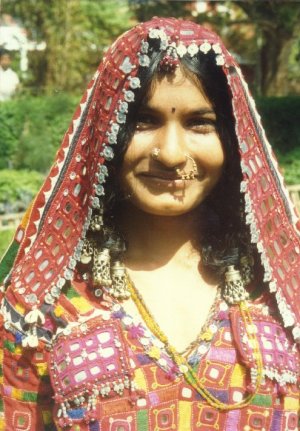An Introduction to Indian Art
by K.L. Kamat
Written: April 26, 2000
First Online: April 01, 2006
Page Last Updated: December 07, 2024
The Indian art and crafts have a very long history. Findings in the Indus Valley, Harappa and Mohenjo-daro stand witness to this statement. Indians have crystallized the art forms, art production and art appreciation for more than ten thousand years.
We see that the Indian artists have had excellent concepts of beauty, symmetry, color, strength of line and form. They studied, in detail, curvaceous female form, the harmony of rounded shapes, anatomical details of the plants and animals. The Indians have infinite number of gods, legends, lore and myths in their culture, and the artists utilized these to give them beautiful forms by creating multi-headed and armed gods and goddesses. This is how we have today exquisite dancing Shiva, bewitching Lord Krishna, portly Ganesha, serene Buddha, menacing ten-headed monsters, charming Apsaras and erotic postures which are distinctive symbols of great Indian art. The artists attained the highest standard of workmanship, skill and extraordinary imagination. The Indian artists and craftsmen have invested tremendous energy and vitality in creating the art treasure of India.
© K. L. Kamat

![]()
Art is found everywhere in India.
![]()
In India, the crafts have never been divorced from art. The Indian homes have a place and value for articles of crafts involving art. Art is found everywhere in India. Common man has an eye for objects that have beauty and utility. They were designed in such way that they will provide enjoyment to the owner while using it. It may be an earthen pot, betel nut cracker or ornaments. art in India was never a showpiece or a museum article.
The East India Company's arrival which made room for the British rule in India changed the conception of art in India. India became an borrower of art and ideas rather than a lender. This new art became "modern" as against earlier form, "traditional art." This change brought an unnatural art style which has little relevance to the lifestyle of an average Indian. This change has came to stay and it spread.
Today, the only way hope for Indian artists for recognition and patronage and is to get into the collections of wealthy and sophisticated patrons, most likely outside of India!
![]()
Articles on Indian Art
- Artist Jamini Roy
- Artist M. F. Husain
- Artist M.J. Shuddhodana of Mysore
- Artist Nandalal Bose
- Arts of India
- Comparing Tanjore and Mysore Schools of Gesso Art
- Expressions of Women in Indian Art
- Functional Arts of India
- Kasooti: Traditional Indian Embroidery
- Leather Puppets of India
- Madhubani or Maithili Paintings
- Pahari Paintings
- Paintings of Rudrakumar Zha
- Paintings of Shubaharay Maharaj
- Paintings of the Daria Daulat Bagh
- Pictures of Puppets of India
- Rangoli -- Painted prayers of India
- Rangoli Patterns
- Ravindra Kalakshetra
- Tanjore School of Painting
- The Art of K.K. Hebbar
- The Artists of India
- The Folk arts of India
- The Ganjifa Art
- The Genius of Ravi Varma
- The Living Arts
- The Marathi Theater
- The Murals of Karnataka
- The Paintings of India
- The Parsi Theater
- The Sculptures of India
- Theatrical Arts -- The Tamasha Theater
- Theatrical Arts of India
- Timeline of Indian Art
See Also:
- Introduction to Handicrafts of India
- Alamkara - 5000 Years of Indian Art -- Online exhibit exploring the notion of ornamentation in Indian art in domestic, religious and courtly settings.

